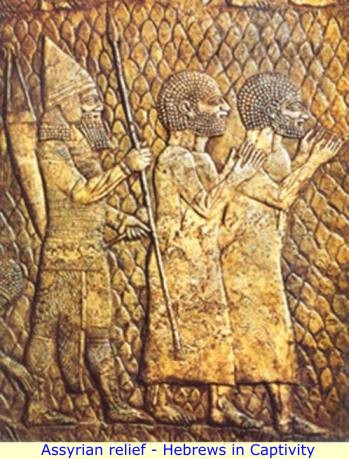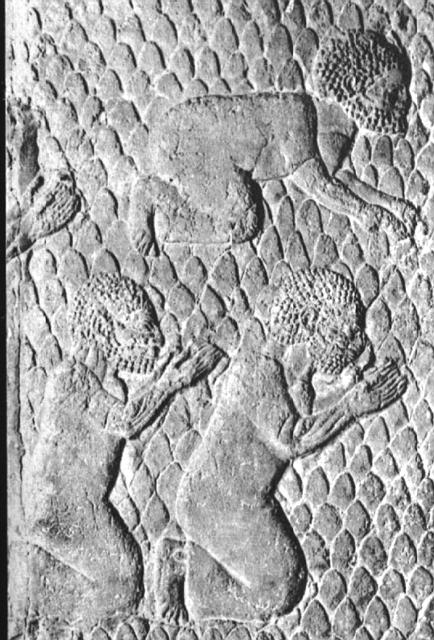

Quote:
| Gaston Maspero describes the Elamites as, " ... A short and robust people of well knit figure with brown skins, Black hair and eyes, who belnnged to the Negritic race which inhabited a considerable part of Asia in pre-historic times ."43 French archaeologist Dieulafoy, one of the first to excavate at Susa, referred to ancient Elam as a prerogative of an Ethiopian dynasty.44 George Rawlinson, once again, records that, "In Susiana, where the Cusheeite blood was maintained in tolerable purity ... there was, if we may trust the Assyrian remains, a very decided prevalence of a negro type of countenance ... The head was covered with short crisp curls; the eye larg~S the nose and mouth nearly in the same 1 ine, the 1 ips thick ... " According to crude, racist, but still regarded by many as eminent, anthropologist Harry Johnston, "The Elamites of Mesopotamia appear to have been a negro people with kinky hair, and to have transmitted this racial type to the Jews and Assyrians." 46 Completing this short 1 ist of· authorities is anthropologist A. C. Haddon who remarks, "There is one portrait of an Elamite (Cusheeite) king on a vase found at Susa; he is painted black and thus belongs to the Cusheeite race." 47 |
Peer Reviewed
Title:
The Kusheeite Origins of Sumer and Elam
Journal Issue:
Ufahamu: A Journal of African Studies, 12(3)
Author:
Dr. Rashidi, Runoko
"In an essay on the people and language of Africa, Richard
Lepnias, concurs with Rawlinson on the origins of the Blackheads:
In the oldest times with the memory of men we know
of only one literary development, viz., that of
Egypt; and we know of only one contemporary people
which could have had knowledge of this culture,
appropriated its results, and conveyed them to
other nations, this was the Kusheeites, the masters
of the Erythraean Sea to its furthest limits. It
was by them that Babylonia was colonized and
fertilized with Egyptian culture. And it is thus
only that the thorough going correspondence between
Babylonian knowledge and institutions and the Egyptian
ones becomes intelligible. The pictorial writing
forming the basis of the cuneiform characters is unmistakeably
only a species of the hieroglyphics; the
astronomy of Babylon is only a development of that of
Egypt . .. its unit of measure, that is, the royal
arcbi tectural ell of 0° 525m, is completely identical
with that of Egypt .•. its architecture, that is to
say, its temples as well as its pyramids and obelisks,
is an imperfect imitation of Egyptian originals;
and so with the other arts. At every step we meet
in Babylonia with the traces of the Egyptian models .• . 22
A brief glance at the Sumerian pantheon provides yet
another tie in the Sumerian Nile Valley connection. In Sumer
the king of the gods, the "god of heaven", was Anu.23 All of
the Sumerian gods and goddesses were Anu's children.24 The
Annunaki were the sons of Anu; the fifty great gods. Flinders
Petrie applies the same term Anu, or as Diop goints"
"The early predominance of the Lower Mesopotamian city the
Sumerians called Kish, one of their most ancient, may be another
bond between the Sumerians and the Nile Valley. The Sumerian
Kush is apparently only a modification of the Nilotic Kush ,
and thus reflects an unsevered connection between the two
territories .
... A most valuable inscription discovered in Ethiopia
in 1914 made it reasonably certain that the Ethiopians
designated their country, or at least a goodly part of
it, as tbe land of Qevs (Kesh) ... It was formerly
thought that Kush or Cush and their derivations were
of Egyptian or Hebrew origin, but the discovery of their
counterparts in an Ethiopian record seem to indicate
that the words were indigenous to the country and
peoples to which they were generally applied.20"
Eurafricans ARE a euphenism for blacks
Quote:
| Although both reports, through their very terminology, reflect the narrow thinking of their day, and ours, the information provided does allow us the opportunity to verify the historical traditions and eye-witness accounts of the Black presence in ancient Sumer We can find no. physical difference between the crania of the "Eurafricans 11 and "Mediterraneans, 11 referred to in these statements and the crania of the African and Asiatic Blacks of today. This data, albeit limited, leaves no doubt as to the racial identity of the region 's early population. Of the fourteen crania from "Y" trench at Kish which Penniman examined he described two as brachycephalic, eight dolichocephalic {Eurafrican), two Armenoid and two mixed. Buxton and Rice studies 26 crania which, accordi ng to their report, consisted of 17 Eurafr icans , five Mediterraneans, who are clearly Austr ics , and four Armenoids.l9 Incredibly, they conclude, there were no traces of Negroid, i.e . , Africoid, blood. Fortunately, we are in a position to form our own conclusions and we can only conclude that we are simply dealing with ethnocentric euphemisms for Black people. |
Quote:
| In 1926, and again in 1928, the Field Museum and Oxford University conducted joint .excavations in northern Sumer. At the conclusion of their work they pronounced: The earliest historical crania (bgpercolichocephali c) are from Jemdet Nasr, 18 miles. northeast of Kish and those from 'Y' trench at Kish •. • The forehead is retreating, the browridges ar~ always prominent, and the cheekbones rather wide. The nose is broad, in some cases inclining to extreme platyrrhine, although the face has seldom survived. This is the type described by Sergi, Giuffrida-Ruggeri and Fleure and named the "Eurafrican" type. • . 15 |
Quote:
| In a direct reference to Lower Mesopotamia itself, pioneer African~American historian Drusilla Dunjee Houston quotes Diodorus as commenting that, "The Cusheeite Ethiopians were the absolute governing class in politics. They commanded the armies and held the offices of state. From them came the ruling families of Babylon."ll And most recently, noted Sierra Leone historian, George 0. Cox, mentions that, "Kush colonized ~esopotamia around 2800 B.C ... . Kusheeite subjects now settled in Babylonia as overlords of Mesopotamia and introduced there what the world has since come to know as Babylonian Civilization."l2 It should be noted that the migration of which Cox writes, was simply a reinforcement by Kusheeites of earlier Blacks |
Quote:
| The Greeks and Romans called the Kusheeites "Ethiopians" and were at least somewhat cognizant of their vast domains. Early observers, such as Ephorus, expres~ly stated that, "The Ethiop'ians occupied all the southern coasts of both Asia and Africa ."7 Homer describes the Ethiopians as "divided," and dwell in~ at the ends of the earth, towards the setting and rising sun." Stabo adds that Greeks ... designated the whole southern countries towards the ocean ... on the coasts of both Asia and Africa, as Ethiopia ."9 According to John D. Baldwin, author of Pre-Historic Nations, and one of the .leading exponents of an early diffusion of Ethiopians or Kusheeites: It is now admitted that a people of the Cusheeite or Ethiopian race, sometimes called Hamites, were the first civilizers and builders throughout Western Asia, and they are traced, by the remains of their language, their architecture, and the influence of their civilization, on both shores of the Mediterranean, in eastern Africa and the Nile valley, in Hindustan, and in the islands of the Indian Seas.lO |
Quote:
| The Sumerians called themselves the Black-headed people and they must have been only one of the many Nilotic Kusheeite colonies established in early Asia. In addition to the biblical reference to Nimrod as a son of Kush, the mighty hunter has been identified with Osiris of the Nile Valley.4 Diodorus Siculus of Sicily, in the section of his work devoted to Kush, reported that O~iris was the leader of the Kusheeite colony that settled in Egypt. The distinguished nineteenth century British antiquarian and Egyptologist, Gerald Massey, concurs with Diodorus adding that, "In Kam or Kush, the Black race of the Aethiopic centre, was the primeval parentage. The name was continued by Kam in Egypt, Kush, Mizraim, Phut and Kanaan represent the four branches in four different directions; and Nimrod is the typical leader into Sumeri -Nimrod the son of Kush, of the Black race. "6 |
Quote:
Susa was generally believed to be the home of Memnon, the great Black warrior-king who is credited by Quintus of Smyrna with, " ... Bringing the countless tribes of his people who live in Ethiopia, land of the Black man," to Priam's Troy in support of his desperate war fg0 survival against the hostile coalition of Greek city-states. " ... Memnon came to helo them. The Trojans were delighted to see him in their city." 51 The story of Memnon was one of the most widely circulated of a non-Hel l enic hero in the world of antiquity. In addition to the references of Quintus and the allusions of Homer, Memnon was also referred to by Hesiod, Virgil, Ovid, Diodorus Siculus, Pausanias, and Strabo, among others. Arctinus of Miletus composed an epic poem, "Ethiopia," in which Memnon was the leading figure. 52 Diodorus records that Memnon led a combined force of ten thousand Susians, and a like number of Ethiopians, along with two hundred chariots to the assistance of the Trojans . 53 According to Robert Graves, in his classic work, The Greek MYths, "Priam had by now persuaded his half-brother, Tithonus of Assyria, to send his son Memnon the Ethiopian to Troy ... Tithonus governed the province of Persia for the Assyrian king Teutamus, Priam's overlord ... He was black as ebony but the handsomest man alive, and like Achilles, wore armour forged by Hephaestus . Some say that he led a la§~e armY of Ethiopians and Indians to Troy by way of Armenia." Memnon distinguished himself in battle and momentarily checked the Greek onslaughter, before he was himself mortally wounded. |
Quote:
| In his, History of Persia, Percy Sykes writes: Some years ago during the course of 11':J travels, I was puzzled by the extremely dark populations of Baskakird and Sarhad, very rerrote and mountainous regions bordering on Persian Baluchistan. The solution may be that the whole country was originally peopled by Negri toes, the Anariakoi of Non-Aryans of the Greeks, who probably stretched along the northern shores of the Persian Gulf to India and that their descendants have survived in those distant parts.63 |




No comments :
Post a Comment
Note: only a member of this blog may post a comment.